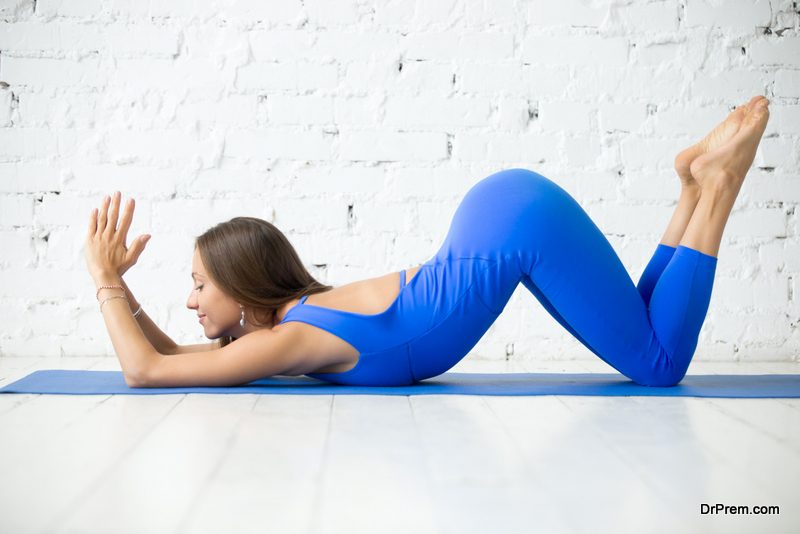There is a constant debate going on about the fact whether pregnant women should practice yoga during pregnancy. It is amazing, however, to notice that the doctors who praise the positive effects of yoga on the health of an individual completely disown the spiritual effects of yoga for pregnant women.
It should, however, be remembered that when a woman is pregnant, she needs to be taken care of and pampered. Yoga helps in achieving these two factors. Practicing yoga is extremely beneficial both for the woman as well as for the baby in her womb, provided she is aware of those postures which may harm her baby in the womb.
The first trimester of your pregnancy is very important for the baby and any wrong yoga posture may harm the baby and lead to miscarriage. To avoid such complications, it is better to be aware of the yoga poses that one should avoid during the first trimester of her pregnancy.
Related article: 11 must have foods for pregnant women in the first trimester
Yoga poses to avoid during pregnancy
Lying down poses
 Lying down on your back in a straight manner as is done in Savasana should not be practiced by any woman during the first three months of her pregnancy. Also, lying on your belly and doing asanas should be avoided by pregnant women. These lying down yoga poses put pressure on the vena cava artery. This leads to the reduced flow of blood and developing the Vena Cava Syndrome. This reduced blood flow will result in dizziness and also harm the unborn baby as it will get less blood than required. Thus, these are one of the most crucial yoga poses to avoid during pregnancy.
Lying down on your back in a straight manner as is done in Savasana should not be practiced by any woman during the first three months of her pregnancy. Also, lying on your belly and doing asanas should be avoided by pregnant women. These lying down yoga poses put pressure on the vena cava artery. This leads to the reduced flow of blood and developing the Vena Cava Syndrome. This reduced blood flow will result in dizziness and also harm the unborn baby as it will get less blood than required. Thus, these are one of the most crucial yoga poses to avoid during pregnancy.
It should always be remembered by women that when they are pregnant, they have to be careful about the asanas that they are doing. For instance in this asana, the reduced blood flow may hamper with your child’s health. Therefore, consulting a doctor before doing this exercise is a good option.
Twisting poses – yoga poses to avoid during pregnancy
Revolved triangle, half prayer twist, and chair twist are some of the twisting poses that a pregnant woman should avoid. These poses include the twisting of the abdomen part of the body along with the other parts of the body. It is best to avoid the twisting poses that require one to twist the abdomen. Poses which focus on twisting the head and shoulders can be practiced instead. Twisting of the abdomen area may lead to putting pressure on the uterus. Revolved side angled asana which is also known as parivrtta parsvakonasana involves twisting of the body sideways. The revolved triangle pose known as parivrtta trikonasana is one of the yoga poses to avoid during pregnancy so that pressure is not put on the uterus and chances of miscarriage are reduced.
Bikram yoga or hot yoga
 The Bikram yoga or commonly known as the hot yoga should be immediately stopped by a woman when she becomes aware that she has conceived. Hot yoga, as the name implies, is practiced in a hot room (or in other words, in a room with high temperatures). Since the body of the pregnant woman during the first trimester undergoes several changes, like the placing of the egg and making space for the egg, this exercise is harmful to the unborn baby in the womb of the woman. Practicing this yoga will lead to a rise in the body temperature of the woman and this will harm the child in the womb. Due to the high temperature, dehydration may occur in women.
The Bikram yoga or commonly known as the hot yoga should be immediately stopped by a woman when she becomes aware that she has conceived. Hot yoga, as the name implies, is practiced in a hot room (or in other words, in a room with high temperatures). Since the body of the pregnant woman during the first trimester undergoes several changes, like the placing of the egg and making space for the egg, this exercise is harmful to the unborn baby in the womb of the woman. Practicing this yoga will lead to a rise in the body temperature of the woman and this will harm the child in the womb. Due to the high temperature, dehydration may occur in women.
This is extremely harmful to the baby as the first three months are critical for the baby. It is during this time that they are placed in the womb and gradually develop with the passage of months. Practicing this yoga has also led to dizziness in many women. During pregnancy, the bodies of the women undergo vast hormonal changes. This changes and the heat leads to dizziness and feelings of unease in the individual. So, hot yoga poses are one of the most important yoga poses to avoid during pregnancy.
Extreme bending poses
The postures which require your body to move forward or down too much can cause much stress on the uterus and abdomen region. Bending backward may put much strain on the spinal cord of the woman and also on the abdomen. These exercises can lead to dislocation of the egg. These exercises leave less space for the abdomen causing pressure to form on it. This is harmful to your baby and will hinder its development. These extreme bending poses will also put much stress on your already stressed out body. Moreover, it will make you feel uneasy after the completion of the exercise itself. Always consult an expert before performing any positions in yoga, especially when you are pregnant.
Inversion poses
 Inverted poses should be avoided by a woman who is pregnant. Practicing the inverted poses may lead to the repositioning of the egg in the first trimester itself. The positioning of the egg takes place during the first three months of pregnancy. Therefore, poses where the individual has to put her feet up in the air and her head on the floor should not be practiced. This may be harmful to the baby. There are inverted poses where the one leg is pulled up and the other down and the head is kept down. This pose is one of the most famous yoga poses to avoid during pregnancy. This may puts pressure on the uterus and may reposition the egg.
Inverted poses should be avoided by a woman who is pregnant. Practicing the inverted poses may lead to the repositioning of the egg in the first trimester itself. The positioning of the egg takes place during the first three months of pregnancy. Therefore, poses where the individual has to put her feet up in the air and her head on the floor should not be practiced. This may be harmful to the baby. There are inverted poses where the one leg is pulled up and the other down and the head is kept down. This pose is one of the most famous yoga poses to avoid during pregnancy. This may puts pressure on the uterus and may reposition the egg.
Jumping poses
Pregnant women should avoid all forms of yoga postures which require them to jump even a little. Jumping during the first three months can do much harm than good for your baby. The egg is placed in the uterus during the first three months and gradually it begins to develop. Any unwanted jumping may lead to dislocation of the egg. And this may lead to future complications in your pregnancy. Excessive breathing occurs during the jumping poses. This can be harmful as this increases your heartbeat and simultaneously the blood pressure of your body. The tree pose should be avoided by pregnant women. Standing on one leg and putting the entire body weight on the other leg can make many individuals lose their balance and they may fall down. This may cause a miscarriage.
9 Exercises you can (and you should) do during first trimester
During pregnancy, high-intensity exercises should be avoided. You should be able to carry out a conversation comfortably all through the exercise duration. Your breath should not constrict or become irregular. Different exercises are suggested for different phases of pregnancy so that they are better suited for the mother and the child. Here are nine exercises that are great for the first trimester of pregnancy.
1. Walking
 Walking is a good exercise all through the pregnancy period because it offers great cardiovascular fitness and boosts circulation of blood and oxygen in the body. Your metabolism rate also improves with walking. Walk at a comfortable pace but not too slow. You can slightly increase your walking pace as you get more used to the exercise. Begin by walking a mile a day and increase to three miles by the end of first trimester.
Walking is a good exercise all through the pregnancy period because it offers great cardiovascular fitness and boosts circulation of blood and oxygen in the body. Your metabolism rate also improves with walking. Walk at a comfortable pace but not too slow. You can slightly increase your walking pace as you get more used to the exercise. Begin by walking a mile a day and increase to three miles by the end of first trimester.
Walking is good through all the weeks of pregnancy. However, avoid walking in polluted places since toxic fumes can be harmful for you and the baby. Early mornings are the best time to walk. Choose parks or other such places that have a lot of greenery so that you have an infusion of fresh air. Wear good footwear that provides comfortable support to the feet. Drink a lot of water before you go on a walk. Also, since the first trimester comes with giddiness, vomiting and fatigue, do not go for a walk outdoors alone; ask somebody to accompany you.
2. Swimming
Swimming is an excellent low-intensity exercise that is good in the first trimester and through all the other phases of pregnancy as well. Swimming makes you feel weightless, provides good support for the body and the risk of injury is almost nil. However, you should not dive at all, not even from low levels. Ease yourself into the water, try floating for the first few minutes, this will make your body feel weightless and also get more attuned to the workout. You can do as many laps as you are comfortable swimming, but make sure you mouth breathe quite often. You will not feel very exhausted if you swim for short intervals. Carry a bottle of water to the pool and keep gulping some after every few laps. Also, twenty minutes of swimming on alternate days will help you sleep better.
3. Pilates
 Pilates are considered to be the most effective and the safest exercises during pregnancy. Beginning these exercises from the first trimester helps in easy delivery. Pilates also ensure stronger abdominal muscles since all the muscles required for child birth are exercised when you perform pilates. These are simple stretching exercises that are easy to learn and can be practiced almost every day, but only after getting an okay from your doctor.
Pilates are considered to be the most effective and the safest exercises during pregnancy. Beginning these exercises from the first trimester helps in easy delivery. Pilates also ensure stronger abdominal muscles since all the muscles required for child birth are exercised when you perform pilates. These are simple stretching exercises that are easy to learn and can be practiced almost every day, but only after getting an okay from your doctor.
Pilates tighten tummy muscles, reduce backache, provide relief from other aches in the body, help maintain a hormonal balance, reduce water retention, ease labor and also help tone limbs and hips. Performing fifteen minutes of pilateseveryday is recommended for every pregnant woman.
4. Yoga
Yoga increases flexibility of the body, strengthens ligaments and reduces mood swings that are experienced during pregnancy. Pains and aches in the body are reduced as well. Yoga is a great stress buster, which is an added incentive since irritability is common in the first trimester. Meditation should be practiced right from the first trimester in order to promote healthy development of the fetus. Sun salutations or suryanamaskar is considered great during the first trimester. Triangle pose, pigeon pose, baddhakonasana, knee to ankle pose, half butterfly and full butterfly poses, ardhachandrasana and warrior poses are also recommended.
5. Simple breathing exercises
 There is something called birthing breath, which is performed in order to ease the baby’s journey out of the womb and also help manage labor pain better. It involves breathing deeply through the nose and exhaling through the mouth. It can be practiced all through pregnancy and you can practice this anywhere, even when lying down. In the first trimester, you can also practice deep breathing. Inhale deeply such that your stomach swells, and exhale while deflating stomach. Deep breathing brings energy and hormonal balance to the body and reduces stress, irritation, mood swings and other symptoms in the first trimester.
There is something called birthing breath, which is performed in order to ease the baby’s journey out of the womb and also help manage labor pain better. It involves breathing deeply through the nose and exhaling through the mouth. It can be practiced all through pregnancy and you can practice this anywhere, even when lying down. In the first trimester, you can also practice deep breathing. Inhale deeply such that your stomach swells, and exhale while deflating stomach. Deep breathing brings energy and hormonal balance to the body and reduces stress, irritation, mood swings and other symptoms in the first trimester.
6. Strength training
The first trimester is the best time to perform strength training as it makes the progressive stages easier. You can use light dumbbells and perform pectoral bench presses, shoulder shrugs, bent over shoulder laterals, lower back hyperextensions and abductors for the inner and outer thigh. Half an hour of strength training exercises every alternate day in the first trimester is good. Light weights should be used and number of repetitions can be increased up to 15. Begin slowly and increase gradually. Do not lift heavy weights. Do not perform strength training exercises that apply pressure on the abdominal muscles or which require you to lie on your stomach. Postures should be perfect in order to avoid injuries to the musculoskeletal system.
7. Kegel exercises
 Kegel exercises are some of the best exercises during pregnancy since they strengthen pelvic muscles. These are recommended from the first trimester and should be continued till the end of pregnancy. The exercise can either be performed lying on your back or while sitting on the floor. Begin by relaxing your pelvic muscles. Then tighten them slowly as if you are trying to stop urine flow. Hold for five seconds and relax. Repeat the process 25 times every day. Increase if you feel comfortable. These exercises were invented by Dr. Arthur Kegel in the 1940s and he prescribed them to all his pregnant patients. There are a number of variations of these exercises that you can try. While contractions remain same, the performing poses change.
Kegel exercises are some of the best exercises during pregnancy since they strengthen pelvic muscles. These are recommended from the first trimester and should be continued till the end of pregnancy. The exercise can either be performed lying on your back or while sitting on the floor. Begin by relaxing your pelvic muscles. Then tighten them slowly as if you are trying to stop urine flow. Hold for five seconds and relax. Repeat the process 25 times every day. Increase if you feel comfortable. These exercises were invented by Dr. Arthur Kegel in the 1940s and he prescribed them to all his pregnant patients. There are a number of variations of these exercises that you can try. While contractions remain same, the performing poses change.
8. Tailor exercises
These exercises strengthen thigh muscles, pelvic region and hips. They also relieve backache. There are two variations that you can try: tailor sit and tailor press. For tailor sit exercises, sit with ankles crossed on the floor. Keep a straight back and slowly lean forward. Back should be relaxed but not arched. Repeat twenty times. For tailor press exercises, bend your knees and keep feet together on the floor. Bend forward, hold ankles and pull knees towards your chest. Inhale while placing hands under the knees and press knees against your palms. Exhale while moving knees away. Repeat ten times.
9. Aerobics
 Aerobics is good in the first trimester but you should not include too many step aerobic exercises. Step aerobics are exercises that require you to lift both legs off the floor simultaneously. High-intensity aerobics can increase body temperature to a large extent, which is not recommended. You can perform moderate intensity exercises in the first trimester and only low-intensity in the subsequent trimesters. Avoid performing aerobics everyday. Three times a week is good enough when pregnant. Also, limit aerobics time up to 30 minutes if your body is used to it and twenty minutes if aerobics is new to you.
Aerobics is good in the first trimester but you should not include too many step aerobic exercises. Step aerobics are exercises that require you to lift both legs off the floor simultaneously. High-intensity aerobics can increase body temperature to a large extent, which is not recommended. You can perform moderate intensity exercises in the first trimester and only low-intensity in the subsequent trimesters. Avoid performing aerobics everyday. Three times a week is good enough when pregnant. Also, limit aerobics time up to 30 minutes if your body is used to it and twenty minutes if aerobics is new to you.
In addition to exercises, diet is very important during the first trimester. You do not need to consume more calories than your normal intake in this phase. Avoid processed foods and foods that contain artificial colors. Fresh foods that are balanced in nutritive value should be consumed. Also cut down on caffeine and stop alcohol and tobacco intake. Fats should be consumed in the form of omega 3 fatty acids, monounsaturated fats and polyunsaturated fats. Drink a lot of water all through pregnancy so that body is well detoxified and blood pressure is kept normal.
First trimester is the beginning of pregnancy and should be used to set up a strong base for the successive months.


